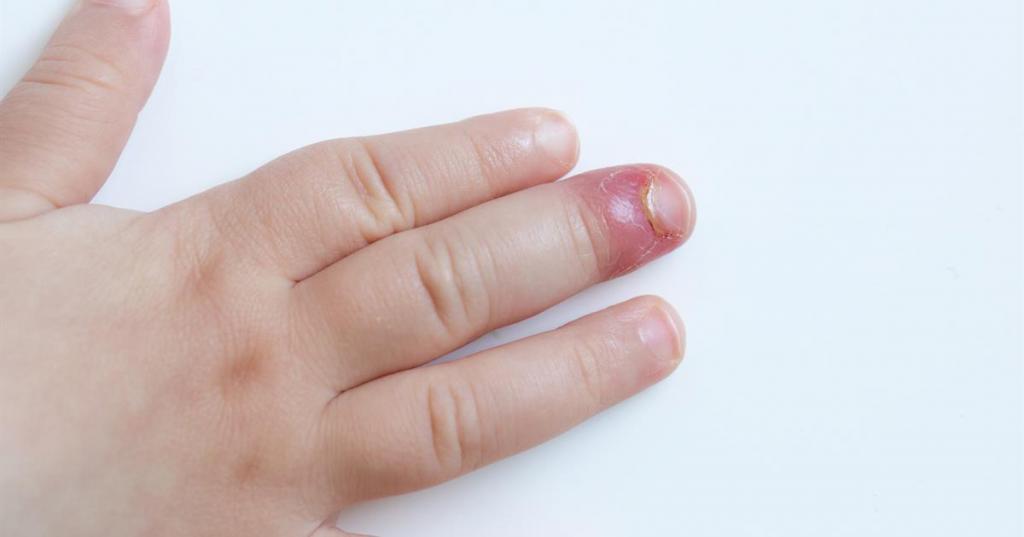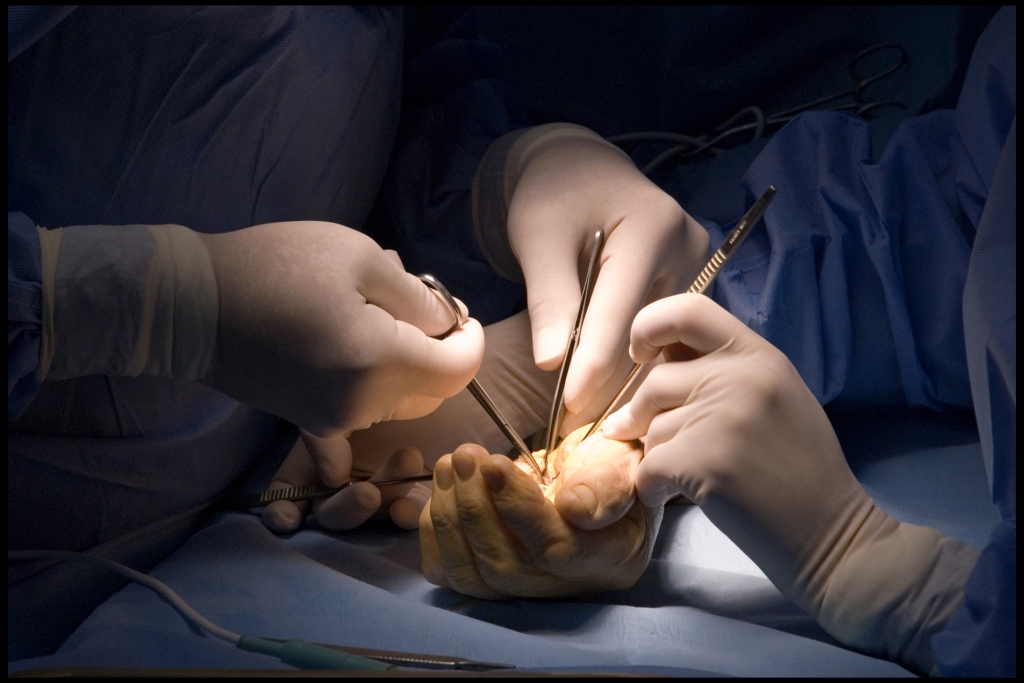Panaritium is a purulent disease of the fingers. It occurs when microorganisms enter through small abrasions and minor wounds under the skin. Manifested by redness, swelling and pain. The initial stage lends itself to conservative treatment using medications and alternative therapy. In the advanced case, when an abscess appears, surgical intervention is necessary. The soft tissues of the fingers promote the suppuration of bones, tendons and joints. Untimely treatment of panaritium on the finger can lead to serious consequences.
General information
Acute suppuration of the fingers (less often the legs) develops as a result of the vital activity of streptococci, staphylococci and Escherichia coli. For their activation, it is sufficient on the surface of the skin to have small abrasions, scuffs, calluses, wounds, as well as subcutaneous splinters, broken glass, and metal shavings. More often, panaritium is found in children and in people of young and middle age who have been injured at work. The first, second and third fingers of the right hand are most damaged. The development of panaritium is promoted by hypothermia, exposure to chemicals, vibration and weakening of the immune system. The palmar surface of the fingers has a large number of tendons, nerves, blood vessels, joint capsules.

Subcutaneous tissue in this area of the arm consists of numerous elastic, strong fibers and bundles of connective tissue. It is divided into small cells and resembles a honeycomb. With this structure, the purulent process easily penetrates deep into the tissues and the joints, tendons, bones, and completely the entire tissue of the finger are involved in it.
Classification of panaritiums
The disease is classified according to the location and nature of tissue damage. The following types of panaritia exist:
- cutaneous - an abscess is located in the thickness of the skin, is considered the easiest form;
- osteoarticular - as a result of the progression of articular panaritium, the joints of the ends of the phalanx bones become inflamed;
- periungual (paronychia) - inflammation is located near the nail roll;
- bone - purulent process develops in the bone;
- subungual - is localized under the nail plate;
- subcutaneous - develops in subcutaneous tissue on the surface of the finger from the palm of the hand;
- articular - metacarpophalangeal or interphalangeal joints are affected;
- tendon - located in the area of the tendon.
Surgery
Conservative therapy is used only for superficial non-purulent forms of infection. With untimely treatment, surgical intervention is mandatory. This method allows you to open the felon, located under the skin, nail, in bone tissue or tendon. Depending on the complexity, the operation is performed under local or general anesthesia. To prevent bleeding, a tourniquet is applied to the forearm and base of the finger. With inflammation of the subungual plate, it is necessary to remove it partially or completely. In bones and tendons damaged by inflammation, necrotic tissue sites are also removed and ulcers cleansed. In severe cases, finger amputation is performed.

During the operation, the surgeon rinses the wound with antiseptic solutions and makes drainage. After opening the felon, the wound is sutured and regular dressings with antiseptic ointments are prescribed. If necessary, use broad-spectrum antibiotics. In addition, to strengthen the immune system, "Antistaphylococcal gamma globulin" is prescribed. To accelerate the healing of the wound surface, physiotherapy is necessarily used: UHF, electrophoresis, x-ray therapy, ultrasound. After the operation, it is very important to give the finger and brush a fixed position, so be sure to impose a splint.
General principles of panaritium therapy
In treatment, the following tactics are used:
- surgical treatment initiated on time - opening of the felon;
- absolute anesthesia;
- bleeding operations - the correct application of a tourniquet;
- rational sections that open access to the lesion;
- complete removal of damaged tissues and good antibacterial treatment of the wound ;
- proper postoperative therapy.
The panaritium should be opened immediately after the diagnosis. You should not wait until the purulent process affects the deeper layers of tissues, tendons or joints.
Treatment of skin panaritium
This is the easiest panaritium. An abscess occurs under the skin after minor damage: corns or a second degree burn. After processing the surgical field, the surgeon performs an opening of the felon and excised the damaged epidermis. The surface of the wound is treated with an antiseptic, carefully inspected so as not to miss the fistulous course. Then apply an alcohol dressing. To heal the wounds, make baths with a slightly pink solution of potassium permanganate.
Antibacterial therapy is used only for complications. As a physiotherapeutic treatment, ultraviolet radiation is prescribed. The period of healing of felon after opening is four days, the wound surface is completely tightened.
Subcutaneous felon
It is often found and requires serious surgical intervention. The patient is tormented by pain in the area of the focus, there is swelling of the phalanx, the body temperature may be slightly increased. The operation is performed under local anesthesia. To open the abscess , an ellipsoidal incision is made along the lateral surface of the phalanx parallel to the palm of the hand. A drain in the form of a rubber strip is inserted into the wound, which allows the outflow of pus. After opening, the treatment of panaritium is controlled by a surgeon. The wound is washed with an antiseptic and a dressing is made with an antimicrobial and wound healing agent. For treatment, irradiation with quartz, UHF sessions are prescribed. Wounds are washed daily through drains and dressings with antiseptic agents until the inflammatory process is eliminated. Sometimes there is panaritium in the form of a cufflink, when one focus is located in the skin, and the second in the subcutaneous tissue. Their message occurs through a fistula. Removing only the skin lesion does not lead to relief, and after opening the panaritium, the finger hurts, since the purulent process is not stopped. The patient has yet another operation.
Okolonogtevy felon (paronychia)
Often, inflammation of the roller near the nail occurs after an unsuccessful manicure or the appearance of a barb. Redness and swelling are observed, then an abscess forms, which is visible through the skin. In the area of inflammation, pain appears. An abscess can open spontaneously, but it is better to seek help from a medical institution to prevent complications. The doctor will determine the treatment: surgery or antimicrobial therapy, which uses antifungal agents or antibiotics. With surgery, the exfoliated epidermis or part of the nail plate under which the pus is removed is removed.
Treatment of the subungual panaritium. What is the name of the operation to open the panaritium?
Usually, the subungual panaritium is a complication after paronychia, but it can also appear after a splinter or small wound near the edge of the nail. In the case of a small lesion of the nail bed at the free edge, a part of the nail plate is resected, removing pus and dead tissue.
With the formation of a purulent process at the base of the nail, Canavele surgery is performed. To do this, make two parallel cuts on the back of the finger. At the same time, they try to injure the tissues of the nail bed as little as possible so as not to deform a new growing nail plate. The damaged part of the nail is cut off, the bed is cleaned. A rubber plate is inserted under the peeled nail, which is removed after two days. After the operation, the nail bed is treated with an antiseptic. For the treatment of nail panaritium, after surgical opening, antibiotics are not required. A bandage with the medicine "Levomekol" or "Levosin" is applied to the sore spot.
UHF, ultraviolet radiation and cryotherapy are prescribed. Wound healing takes 5 to 6 days.
Bony felon
In most cases, it is a complication of subcutaneous panaritium due to improper treatment or not seeking medical help. Soft tissue inflammation extends to bone tissue. This leads to a violation of metabolic processes in it, as a result, bone destruction occurs. For treatment, a club-shaped incision is made. Through which scissors cut out damaged subcutaneous tissue. After that, the affected area of the bone is scraped out. The purulent cavity is cleaned using vacuum and ultrasound, drainage is done, and the wound is sutured. A plaster cast is applied to the sore finger . After an autopsy, panaritium treatment is carried out in full: anti-inflammatory and laser therapy are prescribed. Monitoring the dynamics of treatment is carried out using x-rays.
Tendon felon or tenosynovitis
Tendovaginitis refers to the severe form of panaritium, when not only the function of the finger is impaired, but the general condition of the patient worsens. He is tormented by intense pulsating pains that intensify with the movement of a finger. The finger swells evenly and is in a bent state, it is completely impossible to straighten it because of severe pain. The patient has a fever, confusion, and delirium is possible. Treatment is carried out in a hospital.
After surgery, requiring a large number of incisions, highly effective antibiotics are prescribed, which are administered by injection. After the operation and removal of purulent discharge, several drains are inserted into the cavity in order to better clean the wound. After opening the felon, the finger hurts and the appointment of painkillers is required. Late access to medical care may impair the function of the finger and hand. Most often, the finger has to be amputated.
Treatment of panaritium in children
In a child, panaritium appears in the form of reddening of soft tissues near the nail plate. This is the result of the penetration of pathogenic microorganisms into the epidermis of the skin with a slight finger injury: a slight scratch, abrasion or splinter. Parents should carefully monitor the hands of the child. The most minor damage must be treated with antiseptics. For this, you can use Miramistin, Chlorhexidine, Furacilin, Diamond Green, Hydrogen Peroxide. Simple drugs can prevent the occurrence of a purulent-inflammatory process. It should be noted that the disease progresses rapidly, and when there is an abscess, severe tugging pain, fever, you need to see a doctor or take the child to the trauma unit. Most likely, an operation that is performed under local anesthesia will be required. The surgeon cuts the tissue in the affected area, removes dead skin layers. After opening the panaritium of the finger, everything is thoroughly disinfected, drainage is done, a sterile dressing is applied. If necessary, prescribe antibiotics.
Panaritium Prevention
For the prevention of the disease, the following simple rules must be observed:
- wash your hands often and thoroughly;
- use a moisturizer so that microcracks do not form;
- use gloves when working;
- When cutting fish, be careful not to damage the fingers. When injected with a bone, it is necessary to immediately disinfect the wound;
- Do not injure the skin of the periungual plate during manicure;
- work carefully with a needle, crochet, scissors and knitting needles;
- daily examine the fingers of the child.
If your fingers are damaged, seek medical attention in a timely manner, this will avoid serious problems.
Instead of a conclusion
Any form of panaritium is dangerous and can end in dire consequences. Microorganisms with blood and lymph flow can get from any inflammation to any internal organs, tissues and lead to blood poisoning. In the advanced form, the articular and tendon panaritium leads to the loss of the functions of the finger, and sometimes the palm and forearm. In some cases, the disease ends with amputation. Do not be frivolous about panaritium and self-medicate. If you contact a medical institution in a timely manner, the doctor will open the felon and carry out appropriate postoperative treatment.